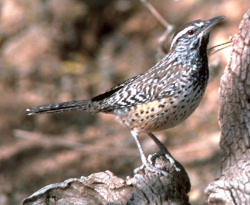|
| 질의: Dark chestnut | 결과: 95번째/101 | |
Wren (Family: Troglodytidae) - wiki
| 제목: | Wren (Family: Troglodytidae) - wiki
| |

| 해상도: 250x205
파일크기: 34411 Bytes
촬영일: : : : :
사진기: Exif Viewer Ver.1.1 (FUJIFILM)
등록시간: 2007:08:20 08:31:33
|
Wren
From Wikipedia, the free encyclopedia
[Photo] Cactus Wren Campylorhynchus brunneicapillus. From U.S. Fish and Wildlife Service Digital Library System
The wrens are passerine birds in the mainly New World family Troglodytidae. There are about 80 species of true wrens in about 20 genera, though the name is also ascribed to other unrelated birds throughout the world.
Troglodyte means "cave-dweller," and the wrens get their scientific name from the tendency of some species to forage in dark crevices. They are mainly small and inconspicuous except for their loud songs. These birds have short wings and a thin down-turned bill. Several species often hold their tails upright. All are insectivorous.
They range in size from the White-bellied Wren (Uropsila leucogastra), which averages under 10 cm (4 inches) and 9 grams, to the Giant Wren (Campylorhynchus chiapensis), which averages at about 22 cm (8.7 inches) and 50 grams (1.8 oz).
Only one species occurs in the Old World, where it is commonly known simply as the "Wren."; it is called Winter Wren in North America.
The 27 Australasian "wren" species in the family Maluridae are unrelated, as are the New Zealand wrens in the family Acanthisittidae.
Species list in taxonomic order
Revised following Mart??nez G??mez et al. (2005) and Mann et al. (2006). The Black-capped Donacobius is an enigmatic species traditionally placed with the wrens more for lack of a more apparent alternative and/or thorough study. It was more recently determined to be most likely closer to certain "warblers", possibly the newly-established Megaluridae, and might constitute a monotypic family (Alstr??m et al. 2006).
Genus Odontorchilus
Gray-mantled Wren Odontorchilus branickii
Tooth-billed Wren Odontorchilus cinereus
Genus Salpinctes - Rock Wren
Genus Microcerculus
Flutist Wren Microcerculus ustulatus
Nightingale Wren Microcerculus philomela
Scaly-breasted Wren Microcerculus marginatus
Wing-banded Wren Microcerculus bambla
Genus Catherpes - Canyon Wren
Genus Hylorchilus
Nava's Wren Hylorchilus navai
Slender-billed Wren Hylorchilus sumichrasti
Genus Campylorhynchus
Band-backed Wren Campylorhynchus zonatus
Bicolored Wren Campylorhynchus griseus
Boucard's Wren Campylorhynchus jocosus
Cactus Wren Campylorhynchus brunneicapillus
Fasciated Wren Campylorhynchus fasciatus
Giant Wren Campylorhynchus chiapensis
Gray-barred Wren Campylorhynchus megalopterus
Rufous-naped Wren Campylorhynchus rufinucha
Spotted Wren Campylorhynchus gularis
Stripe-backed Wren Campylorhynchus nuchalis
Thrush-like Wren Campylorhynchus turdinus
White-headed Wren Campylorhynchus albobrunneus
Yucatan Wren Campylorhynchus yucatanicus
Genus Thryomanes - Bewick's Wren
Genus Thryothorus - Carolina Wren and possibly distinct White-browed Wren
Genus Cinnycerthia
Fulvous Wren Cinnycerthia fulva
Peruvian Wren Cinnycerthia peruana
Rufous Wren Cinnycerthia unirufa
Sharpe's Wren Cinnycerthia olivascens
Genus Cantorchilus (formerly included in Thryothorus)
Stripe-breasted Wren Cantorchilus thoracicus
Stripe-throated Wren Cantorchilus leucopogon
Plain Wren Cantorchilus modestus
Riverside Wren Cantorchilus semibadius
Bay Wren Cantorchilus nigricapillus
Superciliated Wren Cantorchilus superciliaris
Buff-breasted Wren Cantorchilus leucotis (probably not monophyletic)
Fawn-breasted Wren Cantorchilus guarayanus
Long-billed Wren Cantorchilus longirostris
Genus Thryophilus (formerly included in Thryothorus)
Gray Wren Thryophilus griseus (placement in genus requires confirmation)
Rufous-and-white Wren Thryophilus rufalbus
Niceforo's Wren Thryophilus nicefori
Sinaloa Wren Thryophilus sinaloa
Banded Wren Thryophilus pleurostictus
Genus Pheugopedius (formerly included in Thryothorus)
Moustached Wren Pheugopedius genibarbis
Coraya Wren Pheugopedius coraya
Whiskered Wren Pheugopedius mystacalis
Plain-tailed Wren Pheugopedius euophrys
Black-bellied Wren Pheugopedius fasciatoventris
Black-throated Wren Pheugopedius atrogularis
Speckle-breasted Wren Pheugopedius sclateri
Sooty-headed Wren Pheugopedius spadix
Happy Wren Pheugopedius felix
Inca Wren Pheugopedius eisenmanni
Rufous-breasted Wren Pheugopedius rutilus
Spot-breasted Wren Pheugopedius maculipectus
Genus Cyphorhinus
Chestnut-breasted Wren Cyphorhinus thoracicus
Musician Wren Cyphorhinus aradus
Song Wren Cyphorhinus phaeocephalus
Genus Uropsila
White-bellied Wren Uropsila leucogastra
Genus Henicorhina - wood-wrens
Bar-winged Wood-wren Henicorhina leucoptera
Gray-breasted Wood-wren Henicorhina leucophrys
White-breasted Wood-wren Henicorhina leucosticta
Munchique Wood-wren, Henicorhina negreti
Genus Thryorchilus
Timberline Wren Thryorchilus browni
Genus Troglodytes (some 10 species; includes Nannus which may be distinct however)
Genus Cistothorus
Apolinar's Wren Cistothorus apolinari
Marsh Wren Cistothorus palustris
Paramo Wren Cistothorus meridae
Sedge Wren Cistothorus platensis
Genus Ferminia
Zapata Wren Ferminia cerverai
http://en.wikipedia.org/wiki/Wren
| The text in this page is based on the copyrighted Wikipedia article shown in above URL. It is used under the GNU Free Documentation License. You may redistribute it, verbatim or modified, providing that you comply with the terms of the GFDL. |
|
^o^
동물그림창고 똑똑전화 누리집
^o^
|
|

